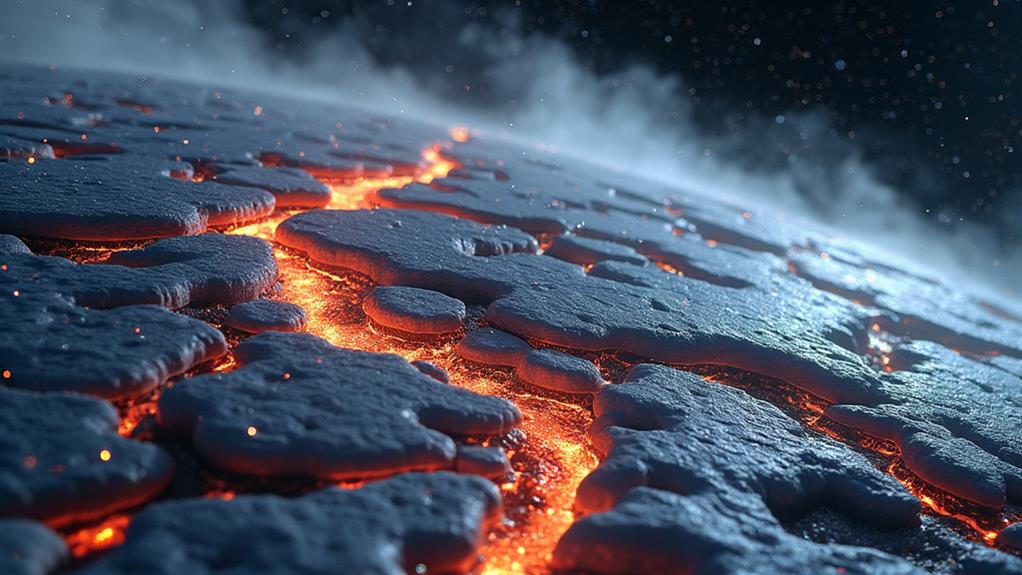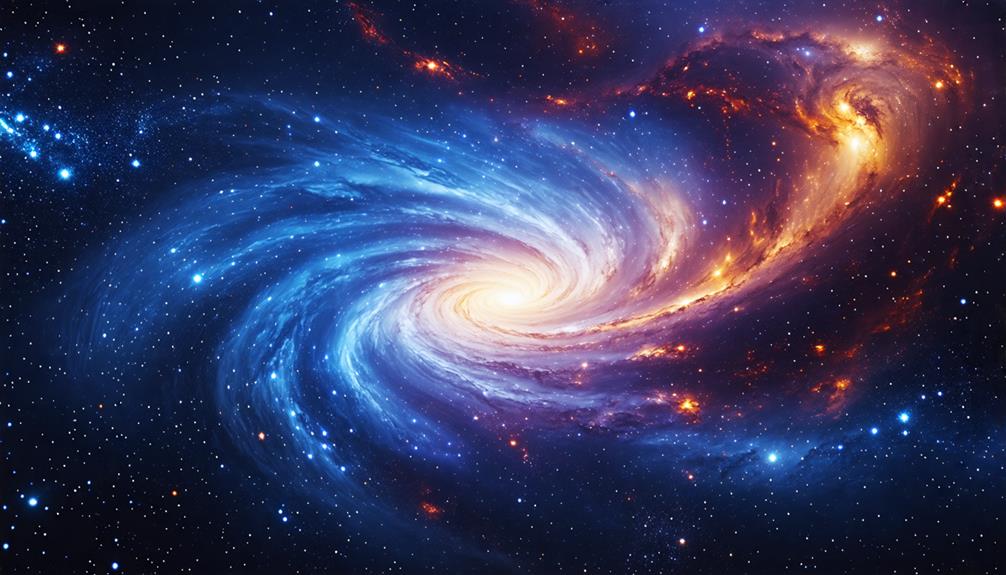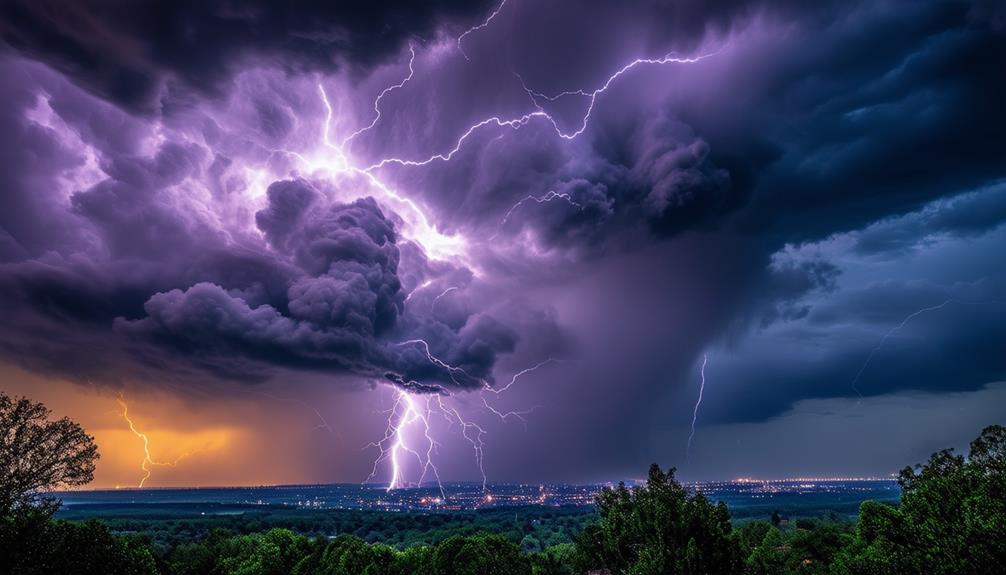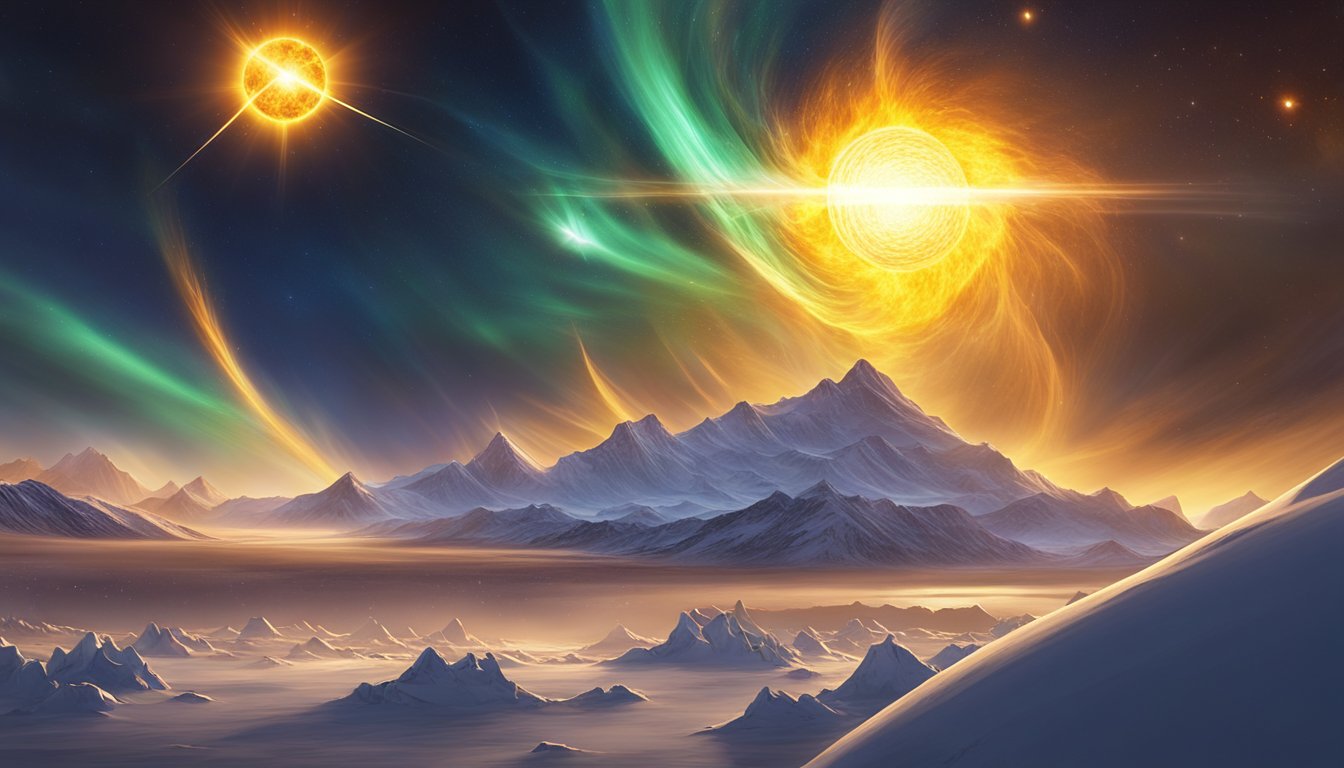Understanding Supernova Explosions
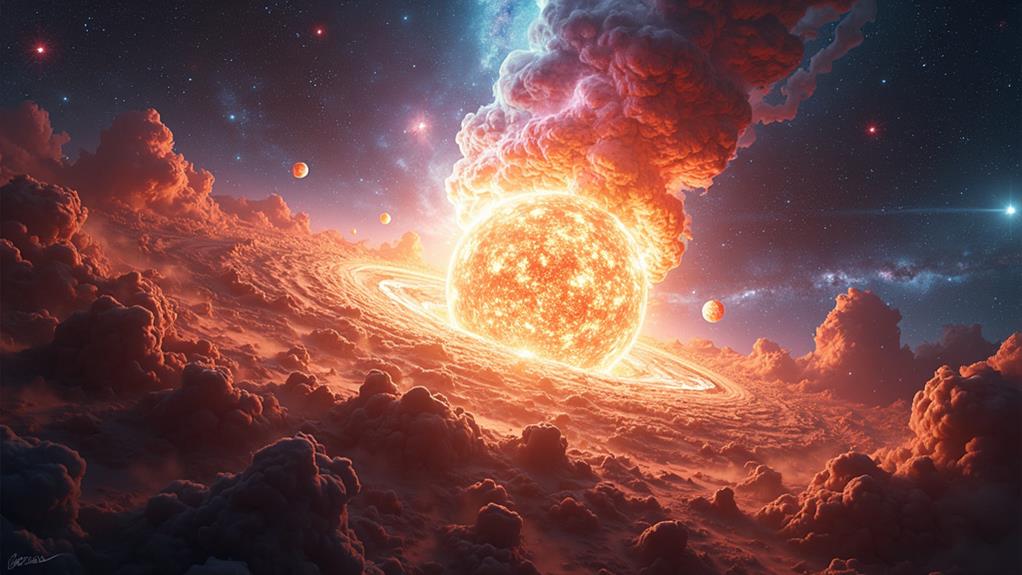
When a supernova explodes, you're witnessing the dramatic death of a massive star. These cosmic events are categorized mainly into Type I, which lack hydrogen, and Type II, which show hydrogen in their spectra. Type Ia supernovae happen in binary systems, while Type II result from a core collapse of massive stars. The brightness can outshine entire galaxies for a short period. Supernovae also play an essential role in synthesizing heavy elements like gold and uranium, enriching the cosmos. This phenomenon isn't just spectacular to observe; it provides significant insights into the life cycles of stars and the evolution of galaxies. Investigate deeper into this cosmic spectacle.
Key Takeaways
- A supernova is the explosive death of a star, leading to a dramatic brightness increase.
- Supernovae are categorized into Type I (no hydrogen) and Type II (with hydrogen).
- Core-collapse and binary system interactions are primary mechanisms of supernova explosions.
- Supernovae contribute to cosmic chemical enrichment by synthesizing heavy elements like gold and uranium.
- Observations of supernovae help understand cosmic distances and the mechanics of stellar explosions.
Definition of Supernovae
A supernova, in its simplest terms, marks the explosive death of a massive star, resulting in a sudden and dramatic increase in brightness that can outshine entire galaxies for weeks or even months. You'll find that supernovae are categorized primarily into two types: Type I and Type II. Type I supernovae show no hydrogen in their spectra and are typically linked to white dwarfs, whereas Type II supernovae display hydrogen lines and result from the core-collapse of massive stars.
When a supernova occurs, the peak brightness can be astonishing, sometimes up to 20 times that of the entire Milky Way galaxy. This incredible luminosity makes them some of the brightest objects in the universe. The explosive death of these stars can lead to the formation of dense neutron stars or even black holes. Additionally, the material ejected during a supernova enriches the interstellar medium with heavy elements, playing a significant role in the formation of new stars and planets.
While Kepler's Supernova in 1604 was the last supernova observed in our Milky Way, the closest observed in modern times is SN 1987A in the Large Magellanic Cloud.
Causes of Supernovae
Supernovae are caused by the dramatic end stages of massive stars. When these stars, typically over five times the mass of our Sun, exhaust their nuclear fuel, their cores can no longer support the immense gravitational forces. This leads to a catastrophic core-collapse. During this collapse, rapid shock waves are generated, ejecting the star's outer layers into space. The remnants of this core-collapse can form either neutron stars or black holes, depending on the mass of the original star.
In some cases, supernovae can also occur in binary systems. Here, a white dwarf star accumulates gas from its companion star. Once this white dwarf exceeds the Chandrasekhar limit, a runaway nuclear reaction ignites, leading to a Type I supernova. This process doesn't involve core-collapse but is similarly explosive.
Both core-collapse supernovae and Type I supernovae are fundamental for cosmic chemical enrichment. The intense energy of these explosions synthesizes heavy elements, scattering them across the universe. These heavy elements are critical for forming new stars, planets, and even life itself. So, supernovae aren't just spectacular celestial events; they play a significant role in the ongoing evolution of the cosmos.
Types of Supernovae
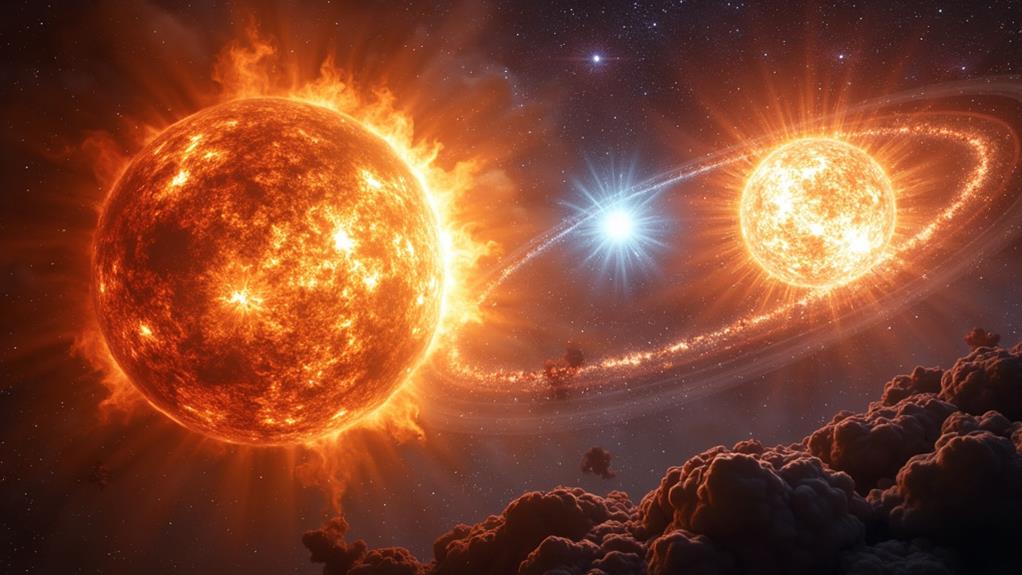
In regards to supernovae, there are two main types you should know about: Type I and Type II. Type I supernovae lack hydrogen lines in their spectra, while Type II supernovae show distinct hydrogen lines. Understanding these types helps you grasp the origins and mechanisms behind these cosmic explosions.
Here's a quick breakdown:
- Type Ia: Occurs in binary systems where a white dwarf accumulates mass from a companion star, leading to a runaway nuclear fusion reaction.
- Type Ib and Ic: Result from the core-collapse of massive stars that have lost their outer hydrogen layers. Type Ib retains some helium, whereas Type Ic lacks both hydrogen and helium lines.
- Type II: Originates from the core-collapse of massive stars, typically greater than eight solar masses. They retain hydrogen lines in their spectra.
- Type II-L and II-P: Subtypes of Type II supernovae, classified based on their light curves. Type II-L shows a linear decline in brightness, while Type II-P exhibits a plateau.
- Spectral features and light curves: essential for classifying supernovae and understanding the progenitor stars and nature of the explosion.
Supernova Brightness
Understanding the types of supernovae lays the groundwork for appreciating their extraordinary brightness. You'll find that supernovae can outshine entire galaxies, radiating more light in a few weeks than the Sun will emit throughout its entire lifetime. This incredible brightness varies depending on the type of supernova. For instance, Type Ia supernovae are often brighter than their Type II counterparts. The peak luminosity of a supernova can reach approximately 10 billion times that of the Sun, making these explosions some of the most powerful in the universe.
Imagine seeing a supernova like SN 1987A with the naked eye, even though it's millions of light-years away. This unimaginable brightness is what makes supernovae so fascinating and useful in astronomy. Type Ia supernovae, in particular, serve as standard candles. Their consistent peak luminosity allows scientists to measure cosmic distances accurately. By comparing the observed brightness of these supernovae to their known peak brightness, you can determine how far away they are. This method is vital for mapping out the vast scale of the universe and understanding the distance between galaxies. Supernovae aren't just powerful explosions; they're significant tools for exploring cosmic distances.
Frequency of Supernovae
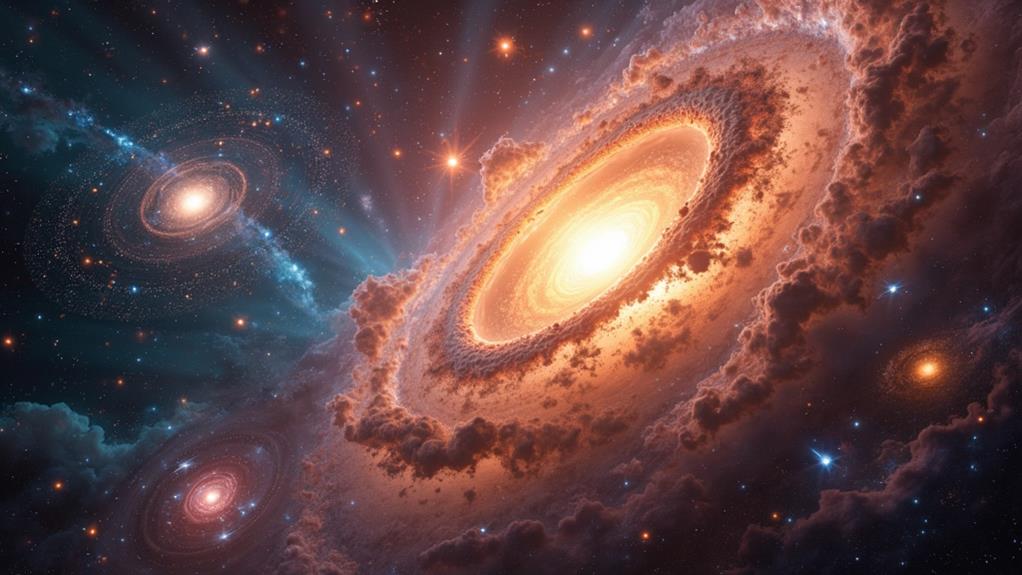
Although it might seem like supernovae are rare events, they actually occur with surprising frequency across the universe. In the Milky Way galaxy alone, supernova explosions happen about 2-3 times per century. On a universal scale, this translates to a star exploding roughly every 10 seconds. However, many supernovae go unobserved due to interstellar dust obscuring our view, leading to an underestimation of their actual frequency.
Historical records of supernova events include notable instances like SN 1006 and SN 1572, which have provided valuable insights into their occurrence over centuries. The frequency of supernovae can vary considerably depending on the galaxy type and environment. For example, denser star-forming regions tend to experience higher rates of these explosive events.
- Supernova explosions in the Milky Way occur 2-3 times per century.
- A star explodes every 10 seconds somewhere in the universe.
- Many supernovae in our galaxy go unobserved due to interstellar dust.
- Dense star-forming regions have higher supernova rates.
- The Local Bubble's structure was influenced by supernovae 10 million years ago.
Supernovae play a vital role in shaping galactic structure, as evidenced by the Local Bubble in the Milky Way. Understanding their frequency helps us grasp their impact on the cosmos.
Scientific Insights
Grasping the frequency of supernovae sets the stage for appreciating their profound scientific insights. Supernovae, particularly Type Ia supernovae, are essential markers for measuring vast cosmic distances due to their consistent luminosity. This ability to gauge distances helps astronomers understand the rate of cosmic expansion, revealing that the universe's expansion is accelerating, a phenomenon attributed to dark energy.
The explosion of massive stars, known as core-collapse supernovae, plays a significant role in stellar evolution. These cataclysmic events synthesize heavy elements like gold and uranium, which are then dispersed into the interstellar medium. This enrichment process is critical for the formation of planets and contributes to the chemical evolution of galaxies.
By studying supernova remnants, you gain insights into the distribution of these elements post-explosion. This knowledge improves our understanding of how supernovae influence the galactic environment. Additionally, supernovae are a goldmine for nuclear astrophysics, providing data on the processes occurring within dying stars.
In essence, supernovae offer a window into the life cycles of stars, the mechanisms driving their explosive deaths, and their lasting impact on the universe's chemical and structural composition.
Observing Supernovae
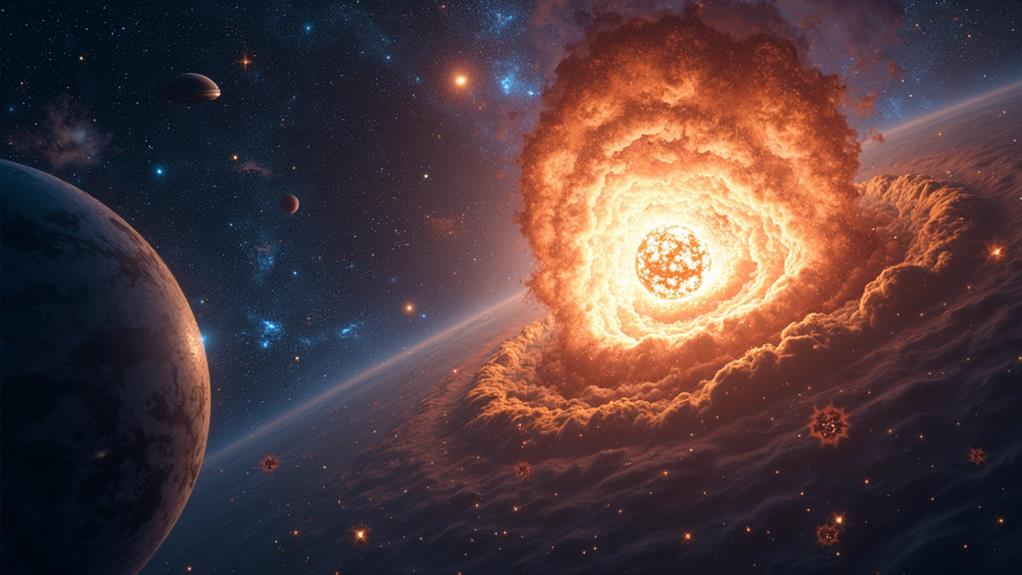
In regards to observing supernovae, advanced telescopes like the Hubble Space Telescope are your best allies, capturing high-resolution images of these cosmic explosions billions of light-years away. These powerful tools let you witness events like Supernova 1987A, which has been continuously monitored for over 30 years. This long-term observation has provided invaluable insights into the supernova's evolution and its surrounding environment.
As an amateur astronomer, you play an essential role in the identification of new supernovae. When you spot a potential supernova, you can report it to the International Astronomical Union's Central Bureau, where it gets classified and named. One of the most exciting findings was SN 2008D, the initial supernova caught in the act of exploding, emitting an unexpected burst of X-rays.
To improve your observing capabilities, here are some tools and projects to take into account:
- Hubble Space Telescope: Offers unparalleled high-resolution images.
- Amateur telescopes: Vital for initial discovery and reporting.
- Neutrino detectors: Projects like SNEWS provide early warnings of supernovae within the Milky Way.
- Online databases: Access past observations and classification data.
- Astronomy clubs: Join for collaborative efforts and shared resources.
Historical Observations
Historical observations of supernovae have provided a wealth of information that continues to shape our understanding of these celestial phenomena. One of the most noteworthy historical supernova events was SN 1006, observed in the Lupus constellation in AD 1006. It's considered the brightest recorded supernova, and its brilliance was noted across diverse cultures.
In 1054, Chinese and Korean astronomers documented another remarkable event: the explosion that resulted in the Crab Nebula. This supernova, observed in the Milky Way, left behind one of the most famous remnants, studied by astronomers to this day. These historical recordings help us understand the frequency and impact of such explosions.
Kepler's Supernova in 1604 was the most recent naked-eye supernova observed in our galaxy. Occurring roughly three times per century, these events offer rare opportunities for considerable scientific advancements. Moving forward, SN 1987A, located in the Large Magellanic Cloud, was the initial nearby supernova observed in centuries and contributed greatly to our understanding of supernova mechanics.
Lastly, the earliest recorded supernova, SN 185, documented by Chinese astronomers in 185 AD, provides valuable historical data. Each of these observations has greatly advanced our knowledge of supernovae and their role within the cosmos.
Frequently Asked Questions
What Happens to a Supernova After It Explodes?
After a supernova explodes, you'll see remnant formation as the outer layers eject, forming nebulae. The core may collapse into neutron stars or black holes. You'll observe a light curve and witness cosmic nucleosynthesis dispersing heavy elements. Shock waves can trigger new stars' birth. Supernova types vary, and some produce gamma ray bursts. Stellar evolution continues, and historical supernovae, like the Crab Nebula, keep emitting light and energy for millennia.
How Many Years Does It Take for a Supernova to Explode?
You might wonder how many years it takes for a supernova to explode. The supernova lifecycle varies based on stellar evolution. For massive stars, core collapse happens after about 10 million years. Neutron stars can merge over millions of years. The light curve shows rapid changes post-explosion. Observations at cosmic distances reveal black holes and the nucleosynthesis process. Essentially, the explosion itself is fast, but the precursor stages are lengthy.
How Rare Is a Supernova Explosion?
Imagine a cosmic firework show; supernovae are the rare, grand finales. Supernova frequency in our galaxy is a cosmic rarity, with about 2-3 per century. Stellar lifecycles culminate in these explosions, but space dust often hides them. Historical records of nearby supernovae highlight their significance. Detection methods and astronomical observations continuously evolve, aiding future predictions. Each type of supernova has distinct galactic implications, shaping both past and future cosmic landscapes.
What Is the Strongest Supernova Explosion?
The strongest supernova explosion recorded is SN 1994W. You'll find these events fascinating in stellar evolution. When massive stars collapse, they can form a neutron star or black hole. Observational techniques help study their light curves and cosmic distance. Explosive nucleosynthesis and gamma ray bursts are key features. Supernova progenitors and remnant clouds provide clues to these powerful explosions, revealing the universe's incredible energy dynamics.

